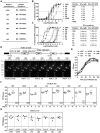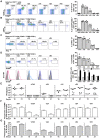Defining immune engagement thresholds for in vivo control of virus-driven lymphoproliferation
- PMID: 24967892
- PMCID: PMC4072806
- DOI: 10.1371/journal.ppat.1004220
Defining immune engagement thresholds for in vivo control of virus-driven lymphoproliferation
Abstract
Persistent infections are subject to constant surveillance by CD8+ cytotoxic T cells (CTL). Their control should therefore depend on MHC class I-restricted epitope presentation. Many epitopes are described for γ-herpesviruses and form a basis for prospective immunotherapies and vaccines. However the quantitative requirements of in vivo immune control for epitope presentation and recognition remain poorly defined. We used Murid Herpesvirus-4 (MuHV-4) to determine for a latently expressed viral epitope how MHC class-I binding and CTL functional avidity impact on host colonization. Tracking MuHV-4 recombinants that differed only in epitope presentation, we found little latitude for sub-optimal MHC class I binding before immune control failed. By contrast, control remained effective across a wide range of T cell functional avidities. Thus, we could define critical engagement thresholds for the in vivo immune control of virus-driven B cell proliferation.
Conflict of interest statement
The authors have declared that no competing interests exist.
Figures





Similar articles
-
A single CD8+ T cell epitope sets the long-term latent load of a murid herpesvirus.PLoS Pathog. 2008 Oct;4(10):e1000177. doi: 10.1371/journal.ppat.1000177. Epub 2008 Oct 10. PLoS Pathog. 2008. PMID: 18846211 Free PMC article.
-
Cutting edge: activation of virus-specific CD4 T cells throughout γ-herpesvirus latency.J Immunol. 2011 Dec 15;187(12):6180-4. doi: 10.4049/jimmunol.1102745. Epub 2011 Nov 11. J Immunol. 2011. PMID: 22079983 Free PMC article.
-
CD4+ T cells specific for a model latency-associated antigen fail to control a gammaherpesvirus in vivo.Eur J Immunol. 2006 Dec;36(12):3186-97. doi: 10.1002/eji.200636164. Eur J Immunol. 2006. PMID: 17109468
-
Immune control of mammalian gamma-herpesviruses: lessons from murid herpesvirus-4.J Gen Virol. 2009 Oct;90(Pt 10):2317-2330. doi: 10.1099/vir.0.013300-0. Epub 2009 Jul 15. J Gen Virol. 2009. PMID: 19605591 Review.
-
A battle for survival: immune control and immune evasion in murine gamma-herpesvirus-68 infection.Microbes Infect. 2002 Sep;4(11):1177-82. doi: 10.1016/s1286-4579(02)01643-x. Microbes Infect. 2002. PMID: 12361918 Review.
Cited by
-
Latency-Associated Nuclear Antigen E3 Ubiquitin Ligase Activity Impacts Gammaherpesvirus-Driven Germinal Center B Cell Proliferation.J Virol. 2016 Aug 12;90(17):7667-83. doi: 10.1128/JVI.00813-16. Print 2016 Sep 1. J Virol. 2016. PMID: 27307564 Free PMC article.
-
Immune Control of γ-Herpesviruses.Viral Immunol. 2020 Apr;33(3):225-232. doi: 10.1089/vim.2019.0080. Epub 2019 Jul 22. Viral Immunol. 2020. PMID: 31334688 Free PMC article.
-
DNA probes that store mechanical information reveal transient piconewton forces applied by T cells.Proc Natl Acad Sci U S A. 2019 Aug 20;116(34):16949-16954. doi: 10.1073/pnas.1904034116. Epub 2019 Aug 7. Proc Natl Acad Sci U S A. 2019. PMID: 31391300 Free PMC article.
References
-
- Stevenson PG, Simas JP, Efstathiou S (2009) Immune control of mammalian gamma-herpesviruses: lessons from murid herpesvirus-4. J Gen Virol 90: 2317–2330. - PubMed
-
- Thorley-Lawson DA (2001) Epstein-Barr virus: exploiting the immune system. Nat Rev Immunol 1: 75–82. - PubMed
-
- Simas JP, Efstathiou S (1998) Murine gammaherpesvirus 68: a model for the study of gammaherpesvirus pathogenesis. Trends Microbiol 6: 276–282. - PubMed
Publication types
MeSH terms
Substances
LinkOut - more resources
Full Text Sources
Other Literature Sources
Molecular Biology Databases
Research Materials

